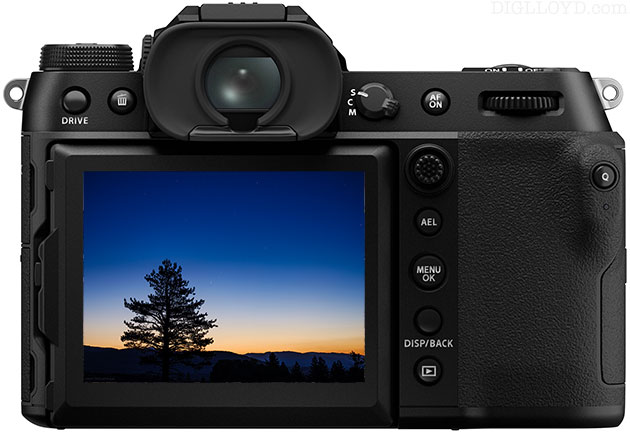Reader Comments: Fujifilm GFX100S
I am hoping to receive my own Fujifilm GFX100S soon. See also:
Lug Rings for Easily Connecting Any Camera Strap on Fujifilm GFX100S, Leica M10-R, Leica M10M, other cameras with small-hole lugs
3rd-Party Lenses for Nikon Z, Canon RF, Sony E, Fujifilm GF Mirrorless Cameras
Best Lenses for the Fujifilm GFX100S + Equivalent Focal Length and F-Stop vs 35mm Format
Fujifilm GFX100S...
Given some reader reactions to the first part of Roy P’s note below, I thought I would preface it as follows because it could be mistaken for disappointment—read all his comments as well as the other readers before judging. I think he makes some fair points on the negative side, but like him, on the whole I think the GFX100S is a major breakthrough for what it delivers at such a relatively low price point.
...
Comparing the facilities of cameras even if they are designed for different target audiences lends clarity for anyone who lacks firsthand knowledge or is just trying to approach the subject. To say that such comparisons are invalid would presuppose knowledge of both. But if you don’t know, you don’t know.
As just one of many potential examples: for portraits, choose the Sony A1 for high speed high-competence Eye AF and focus tracking, or choose the Fujifilm GFX100S for high resolution and a different 'look', but suffer the inferior AF performance? Nor is even landscape use clearcut—there are many considerations involved.
To understand the range of competences across cameras, I try to minimize my assumptions about the vague “target market”, or presumed camera competence. I like to look at the actual strengths and weaknesses because sometimes there are surprises, and sometimes a camera’s competence drops below an acceptable threshold (whatever the issue might be).
How else to choose the best tool for the job, or to understand whether a camera is poor/good/excellent at any particular task? Particularly when it means deciding on a single-camera system or dual system eg Sony + Fujifilm. To do that and to decide on lenses, it’s important to know where camera competence falls too short.
To use an analogy, I might compare my Sprinter van to an SUV— it’s a bit “ridiculous” from my perspective now that I have years of experience and knowledge. And yet it’s very useful for anyone who does not know what to expect. Same idea when comparing Sony A1 to the GFX100S.

|

|

|

|

|

$1799 SAVE $500 = 21.0% FUJIFILM 80mm f/1.7 GF R WR Lens (FUJIFILM G) IN STOCK in Lenses: Medium Format
|

|

|
Roy P writes
Some of the oddities that Roy refers to here might be due to various settings that once changed make certain behaviors improve/change. His comments were never claimed to be a review on his part, only initial reactions/impressions. See my inline notes as well as comments that follow.
Written to me not necessarily written for publication but which I found interesting as “first impressions”... so please read as such. Also Roy is having concurrent experiences with the Sony A1 and Olympus E-M1X and I find that interesting to juxtapose, even if the cameras have very different target usages and customers.

First, let me cover the bad news: the Fujifilm GFX100S ergonomics really suck in every way you can think of. It’s almost like their design goal was to make it as frustrating as possible.
Compared to the Olympus E-M1X and the new Sony A1 menus, the Fujifilm menu system looks like the product of a class project in a JAVA programming course at a community college.
In the AF/MF menu, there’s an entire page of menu items that seems to be missing. You see pages 1/3 and 2/3, but there is no 3/3. You certainly get the sense that you’re not playing with a full deck of cards.
The grip and the shape of the camera are designed so it feels like you are wearing your left shoe on your right foot. It kinda, sorta has all the contours, but it puts pressure in the wrong places.
[diglloyd: of course hand fit can be a personal thing, and I have yet to handle the GFX100S. But it’s pretty darn important if your hands don’t fit a camera well, or the grip is poor]
The rear AF button would be too tiny on a Sony NEX camera. It is a pain to find it or know you’re pressing it even with bare hands, and it is very tough to use it with gloved hands unless you have a thumb opening in the glove.
[diglloyd: agree wholeheartedly—the Canon EOS R had this problem too. And since I prefer AF-ON to AF-with-shutter, it's a negative to be enjoyed frequently—bummer]
I have no idea what the rear control wheel does – either it changes the shutter speed (the front control wheel already does that) or it does nothing. The only way I can change the aperture is with the ring. Setting the ring to A or C does not let me change the f-stop from the camera. ===> Figured out the solution to this. I am used to lenses that have an aperture ring show the f-stops, then an A at the end. If you set the ring to A, then you can control the f-stop from the camera. The Fujifilm lenses have an A, which is used for programmed auto exposure, and also a C setting. You need to set the ring to C to adjust the f-stop from the camera. Otherwise, the rear wheel does not adjust the aperture.The AF-C mode is shaky. The lens reasonably finds and focuses on the target, but then endlessly keeps stepping forward and backward, noisily, and the subject keeps falling into and going out of focus. When you click, you don’t know what you’re grabbing – in or out of focus.
The autofocus tracking is confusing, weak and slow. It’s a PITA to acquire focus or track subjects. After being used to my favorite AF-C modes in the Sony cameras and tested the Olympus E-M1X (e.g., use Center AF to initially acquire the focus, then recompose or track the subject as it moves, and the camera holds on to the subject like an crocodile’s jaw), the Fujifilm feels inept.
[diglloyd: fair comment, but Roy and the rest of us probably weren't expecting Sony A1 or even Sony A7R IV performance here]
There are some other goofy things, like the camera took some shots with alternating bright and dark stripes. I have no idea what it was doing. The battery power had gotten near zero, so I don’t know if that was the problem. After I charged the battery again, I did not see this problem again: <image001.png>
[diglloyd: prominent bands seen. I had thought that the bands referenced are caused by 120 Hz lighting interacting with the sensor transit time of the electronic shutter. Other cameras when used with electronic shutter variants will show the same issue. See Sensor Readout Transit Time for 16-bit vs 14-bit Capture. HOWEVER, Roy states that after charging the battery and redoing the image with no other changes and under INCANDESCENT lighting the bands then disappeared, raising the issue of a camera bug]
But setting aside those, there are some very impressive things about this camera. There is really superb potential here.
I initially got into the Fujifilm as my “street photography” camera, with just one lens, the 50/3.5 which I bought last year when B&H had that absurd $500 off sale on a $1000 lens. But when Fujifilm announced the 80/1.7, I thought this was the one lens I’d rather have, and I had second thoughts about the 50/3.5.
Now that I’ve used both lenses, I can tell you they are both keepers. The 50/3.5 is just amazing, and the 80/1.7, is also a fantastic lens, although it has both purple fringing (easily fixable in post) and some LOCA, harder to fix, but it does not look ugly. Otherwise, it’s razor sharp even wide open, and the details at the pixel level it reveals on a 100 MP sensor are very impressive. See attached actual pixels crop (that also shows some green streaks in the OOF background structures).
The IBIS is unexpectedly good and effective. After seeing the superb IBIS in the Olympus E-M1X and the somewhat less obvious IBIS in Sony cameras, I expected the IS to be even less obvious or effective in the Fuji, given its big sensor size. So I was pleasantly surprised at how well Fujifilm IBIS works. But it comes at a price: when you click the shutter, you hear one beep, but that is not the shutter release. It looks like the start of the IS process. You need to wait for a second beep, sometimes like a second later, for the shutter release. If you move the camera before then, this is what happens: <jello image>
[diglloyd: the funky “jello” results are due to sensor transit time and movement; see Blur and Image Deformation with Fully Electronic Shutter.]
Another problem with the IBIS is, from the time you click the shutter button to the time it actually captures the image, the screen blacks out (even with a fully ES shutter) and you don’t really know what the camera is capturing.
There are some IBIS modes (and a whole bunch of other focus and exposure related features) I still need to experiment with.
But what I have seen in just two days has made it very clear that this is a fantastic sensor and at least the two lenses I have are superb. I could never get any of the Schneider Kreuznach lenses on my Phase One XF with the IQ3 100 MP sensor deliver this level of sharpness when using autofocusing, even after burning many, many hours setting up focus trim for the lenses. I just don’t see how any DSLR can match the autofocusing a mirrorless camera can deliver. The camera turns on and is ready to go surprisingly fast. I love the digital split prism for manual focusing. The eye AF is pretty impressive, and I haven’t even fully figured out all the AF modes.
Net-net, even with a lot of warts, the GFX 100S is a very useable and impressive camera, and it might take a Mark II a couple of years down the road for Fujifilm to streamline the camera and iron out all the wrinkles. But in the meantime, the current 100S is more than an adequate placeholder and a very functional camera. Its price point makes it even more compelling – I’d have no qualms about using it for a couple of years and replacing it with a Mark II.
So I am rethinking my medium format strategy. I will likely end up selling most of my Schneider lenses that I would normally use with autofocusing. I am not sure if I will get out the XF altogether – I will probably still have a minimal XF system, but increasingly, an XT + just one or two Rodenstock lenses for landscapes, plus the Fujifilm GFX system for everything else, is becoming far more appealing!
So I’m thinking of a Fujifilm GFX as a system now. Below is my plan of action… If you have nothing better to do, you’re welcome to take a look and share any thoughts :)
...remainder omitted...
DIGLLOYD: the Fujifilm menu system can lead to some confusion, perhaps that blank page thing (page 3/3 not seen) is one of those cases I've seen before (I forget which cameras) where you have to scroll down one more time over a blank page in order to see the next page.
The bands referenced look like shose caused 120 Hz lighting (38 bands). Other cameras when used with electronic shutter variants will show the same issue. However, Roy states that he repeated the test with a fully charged battery and the bands disappeared—and the lighting was incandescent to begin with and no changes were made to settings. Maybe there is a bug with low battery, maybe he made a mistake, dunno.
Roy P follow up:
BTW, the first time around, the camera had gotten into some mode that the Fujifilm technician couldn’t figure out after some 10-12 minutes of trying to change some settings. So he had me reset the camera and start from scratch. That eliminated whatever twilight zone mode the camera had fallen into
That’s when the tech told me it’s possible to make conflicting settings that confuses the camera, and if that happens again, I should simply reset the shooting mode. This is done via the Wrench => User Settings => Reset
DIGLLOYD: I myself rememember running into some GFX50S and GFX100 bugs. Looks like there are still a few issues. Having to do a reset is a huge time-waster—yuck.
Roy P continues:
Wow, the IBIS impresses. Attached is an actual pixels crop from a shot at 1/40 s and 800 ISO with the 50/3.5 – I actually slipped while taking this shot and the camera was actually moving ever so slightly as I was clicking, with the camera held just by my hands in free air, with no support from my face. I had expected nothing but a blur! Not only I got a decent image, the camera even nailed eye AF.
There is a lot of programmability built into the camera, and with six custom modes, two fully programmable buttons, a semi-programmable front control dial, dedicated buttons for drive mode select, S/C/M focusing mode, exposure comp, and a quick access button that is very similar to the Fn button on the Sony, I now have the GFX 100S more or less mirror my Sony A1 configuration, except for the physical locations of the controls. That’s not too bad, I could get used to it.
The autofocus acquisition and tracking is not as nimble as it is in the Sony A1, but nothing else is (the Oly E-M1X comes close, and the Canon R5 probably is there somewhere in the same zip code as well). But I won’t be using the GFX 100S for BIF photography anyway, although with some practice, I think I will get a lot more mileage out of it for action photography.
As much as I hate reading manuals, I think I have to plough through the 100S book. It’s 368 half-pages, so it will take some time, but to get the most out of the camera, it’s worth a read, just to figure out what things mean in Fuji’s lingo. For instance, you need to read the manual to learn that “Focus Lever” means the frigging joystick on the back!
For me the biggest irritant is going to be the tiny AF ON button in the back. So this is something I will need to get used to. Also, instead of the L bracket, I’m getting the $149 Fujifilm “metal handgrip” for the 100S:
One dumb thing they did in this was to prevent access to the battery compartment, which means I’d have to take off this plate to change batteries (hmm, where have I run into this problem before?!). But the positives are, it has a nice finish and I expect it will address one of my gripes about the 100S (handling). It also has an ARCA bottom plate. That’s all I need, I don’t need an L bracket.
So net-net, I’m making the GFX a big part of my photography. The GFX 100S is finally giving me more than anything I could have ever dreamed with my Leica S system. Having suffered through the Leica S for 5+ years, it’s really exciting to use the Fujifilm and get so much more for one third the price of a Leica S3!
...
The first thing you must remember to do if you ever reset the settings: change the recording format to RAW (unless JPEG is what you want). I have no idea why camera manufacturers default the recording format JPEG. I think this is really nuts.
This is a nice feature: the front dial defaults to S.S. (shutter speed, not very readable here), but the dial itself is clickable, and if you click it, you can set a second function (which I have set to ISO), and if you click it again, you can set it to aperture setting (which is redundant). This is not a totally programmable function, so I can’t set it to say, WB. Too bad. But SS / ISO is nice.
The rear dial is also clickable, but I can’t seem to get other options I can set with it, so it’s set to aperture.
Exposure compensation works nicely – there’s a dedicated button next to the shutter release, and if you press it, while you have it pressed, you can use your thumb to turn the rear dial to change exposure comp. That is very handy.
What’s going to drive you crazy on cold days, especially at the places where you routinely go: both the AF ON button on the rear and the exposure comp button in the front are really, really tiny. It’s very tough to operate them with gloved hands.

|

|

$173 SAVE $35 = 16.0% Sony 128GB SF-G TOUGH Series UHS-II SDXC Memory Card IN STOCK in Accessories: Memory Cards
|

$58 SAVE $10 = 14.0% Sony 128GB SF-M Tough Series UHS-II SDXC Memory Card IN STOCK in Accessories: Memory Cards
|

$113 SAVE $15 = 11.0% Sony 256GB SF-M Tough Series UHS-II SDXC Memory Card IN STOCK in Accessories: Memory Cards
|

|
Staale S writes:
I got the Fujifilm GFX100S the other day, but it seems that one of your subscribers “Roy P” has gotten an all together different camera then mine, though I NEVER use anything else than “M”.
But apart from the UI, which I think sucks on all cameras, except from the A7S III, that shows a slight improvement, this is all around a fantastic camera and the IQ is just mind boggling. Even handheld one is able to make fantastic landscape shots. The step up, from my 50R is unbelievable, at least to my eyes.
DIGLLOYD: the context here is having the Fujifilm GFX100S, Sony A1, Olympus E-M1X all together at the same time. Given that, I can understand that the GFX100S operational and ergonomics suffers by comparison.
Based on using the Fujifilm GFX100 for a few months over the past three years, I expect that used for what it’s best at (landscape and some other things), the GFX100S is a major breakthrough. It will be very welcome for outdoor activities.
Joseph C writes:
It sounds like Roy has encountered some firmware bugs or function interactions of some kind. I don’t doubt that there is instability at this point in the product cycle. I’ve run into it with every new camera model I’ve purchased in the past 5-10 years (since the initial Sony A7R). Hasselblad was the worst. Fujifilm has a habit (with their X-system) of launching a product and coming along soon thereafter with a firmware update to fix bugs and improve stability. The early adopters like me and Roy are therefore beta testers. I’m a self-confessed early adopter.
Some things I’d point you to with the 100S:
- The menu tree is too deep and convoluted. The Sony a1, from what I’ve read and seen online, has done a far better job of menu organization than most of the other camera makers.
- The AF On button is too small and almost flush with the back of the camera. I use back-button AF most of the time, so this is something I’ll have to norm to.
- The joystick seems “skippy”, meaning that an upward, downward or sideways press doesn’t always result in the expected action.
- IBIS is amazing, in a good way. I’m shooting at shutter speeds I never imagined I could use with a 102MP camera.
- The EVF is underwhelming. Fujifilm could have done waaaay better than using the old 3.69M dot EVF.
- Eye and Face AF works OK for me. I used it successfully to photography my granddaughter last week and the results were quite acceptable.
- Fuji’s support team is accessible by email or phone, something I can’t say about the others. I know because I’ve had to contact them about the camera.
- Since I shoot primarily landscapes, I’m not bothered by not having Animal AF or super-teles.
Like you, I wonder why Fujifilm hasn’t put more horsepower into the camera or lenses. It’s definitely a game changer in the 44x33mm segment, but doesn’t match the Sony A7R IV or Sony A1 in terms of functionality. The native lenses are not a concern for me due to my subject matter. Your reviews have given me enough information to know how to use each one. The GF 80mm f/1.7, while being a stellar lens in terms of IQ, tends to hunt and is slower to focus than the GF 110mm. I prefer the latter.
Finally, in full disclosure, I had to return my first copy of the 100S to B&H because it developed a bug. The battery indicator disappeared from both the rear LCD and the top LCD. I had several exchanges with Fujifilm support and decided to get a new copy. Fortunately, I was able to get a new one via Camera West. So to support Roy, he may have a buggy copy or may have run into some instability that will eventually be fixed by Fujifilm. I hope that your experience is positive and rewarding.
...I’m using the 3 Legged Thing “Ellie” L-bracket until RRS or Kirk introduce one specifically for the 100S. The Ellie allows access to the battery without removing the plate, the latter being a disadvantage of using the Fujifilm Metal Handgrip.
The 100S works well with the Fuji iOS app, allowing me to automatically geotag my photos while carrying my iPhone. I can also use the app as a remote.
There is no charger included with the 100S, so I’d recommend buying the dual battery charger to avoid having to charge the battery in-camera.
DIGLLOYD: sounds about right.




























